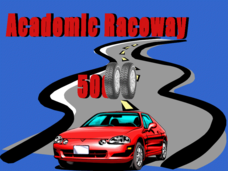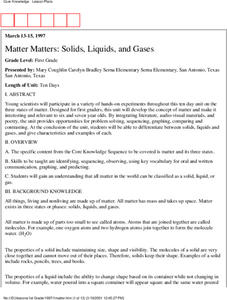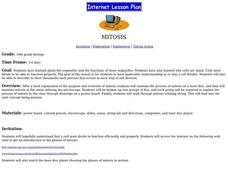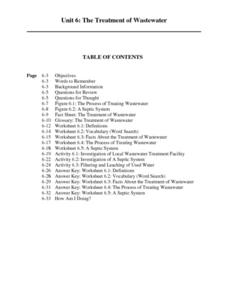Curated OER
Chemical Equilibrium Worksheet #1
In this chemical equilibrium worksheet, students list 4 ways to increase the concentration of the product. They answer 9 multiple choice questions about equilibrium reactions.
Curated OER
Ecology of the Savanna-Forest Boundaries in Central Brazil
Learners explore photosynthesis. In this photosynthesis lesson, students label parts of photosynthesis and take notes. Learners conduct experiments on leaves, make observations and record their findings.
Curated OER
Academic Raceway: Animals
This animals PowerPoint provides a race car game in which students answer a variety of questions about animals, the majority of which are based on ways in which animals adapt to their surroundings and behave to survive.
Curated OER
The Discovery of Photosynthesis
Learners explore how scientists discover photosynthesis. In this biology lesson, students identify the basic requirements for photosynthesis to happen. They recreate past scientists' experiments and record their observations.
Curated OER
Carbon Dioxide
High schoolers conduct a series of experiments to explore carbon dioxide properties. In this chemistry lesson, students explain the production and uses of this gas. They measure its amount in soda and waste product of yeast.
Curated OER
Electrolysis
Students conduct a series of experiments on water electrolysis. In this chemistry lesson, students explain what happens to the molecules during the process. They cite real world applications of electrolysis.
Curated OER
Water
Students conduct a series of investigations on the unique properties of water. In this general science lesson, students explain what causes water's surface tension. They explain the different stages in the water cycle.
Curated OER
Ionic, Covalent, and Metallic Bonding
You may want to make a few changes before sharing this slide show with your chemistry class. For one, remove the bright blue swirly background that makes the black font hard to read. Ionic bonds are described with the use of an electron...
Curated OER
Leaf Stomata as Bioindicators of Environmental Change
Students, in this experiment, collect leaves from two species of trees and the stomatal index on the upper and lower epidermis of each leaf be determined.
Curated OER
Matter Matters: Solids, Liquids and Gases
Scientists participate in a variety of hands-on experiments in this ten-day unit on the three states of matter. Lessons incorporate literature, a-v materials, and poetry to help students differentiate between solids, liquids and gases.
Curated OER
How Does a Green Plant Grow?
Students of all ages can explore the question "how do seeds grow?", design an experiment to answer the question, predict the outcome of the experiment then conduct the experiment.
Curated OER
Rainforest
Students examine how important the rainforest and its resources are for our everyday survival in the future.
Curated OER
Meat, Poultry, Fish, Eggs: Constructing and Maintaining
Meat as a food source to provide necessary complete protein, iron, and other nutrients in the diet. Identify and prepare meats and/or poultry product(s). National Standard 14.3.3
Curated OER
Non-nutrients: Fiber and Water
Students will identify the sources and function of carbohydrates and fiber and apply appropriate food preparation techniques.
Curated OER
Essential Nutrients - Daily Guides
List the recommended dietary guidelines and explain their function and implementation. (The guidelines are listed below) National Standards 14.3.1 Aim for fitness Aim for a healthy weight Be physically active each day
Curated OER
Making Molecular Models
In these creative hands-on activities, students construct several different molecular models that represent substances that play an essential role in our nutritional needs. Using gum drops and toothpicks, students design the models....
Curated OER
Extra! Extra!
Learners describe how plants and animals depend on each other. They see how living and nonliving environments change over time. They identify ways in which humans have changed their environment and the effects of those changes.
Curated OER
MITOSIS
Tenth graders examine the process of mitosis on a laser disc. They examine mitosis in an onion utilizing the microscope.
Curated OER
Gray Whales
Explore the majestic grey whale while deepening your understanding of animal adaptations. Grey whales from head to toe are specifically designed to fit their environment. Learners will examine the ways in which the flippers, head, body,...
Curated OER
Non Native Species: English Ivy-Landscape Plant or Deadly Killer?
Students study the impact that invasive species have on biodiversity and more natural areas.
Curated OER
What Plants Need in Order to Survive and Grow: Light
Students conduct an experiment to evaluate whether plants need light to survive and grow. They observe and gather data about plant responses to different growth regimes, analyze the data, and make conclusions about basic plant needs.
Curated OER
The Treatment of Wastewater
Students, through a series of lessons, study the various processes of treating wastewater. They participate in discussion and complete various worksheets and a hands-on activity, in which they observe the processes of filtration and...
Curated OER
Explore: Third Grade Scents
Students use the olfactory sense to determine if a marker is appropriate 'food' or not. This experience helps students explain why so many animals rely on the sense of smell to find prey.
Curated OER
Bog Science
Students study bogs. They tour, collect physical, chemical, and biological data and analyze a pristine bog community. Using the data, they draw a map and a cross section of the bog.
Other popular searches
- Carbon Dioxide Oxygen Cycle
- Dissolved Oxygen
- Oxygen and the Human Body
- Oxygen Cycle
- Oxygen and Carbon Dioxide
- Carbon Oxygen Cycle
- Oxygen Carbon Dioxide
- Oxygen Cycle Diagram
- Solubility Oxygen
- Mount Everest Without Oxygen
- Plants and Oxygen
- Transporting Oxygen, Glucose

























